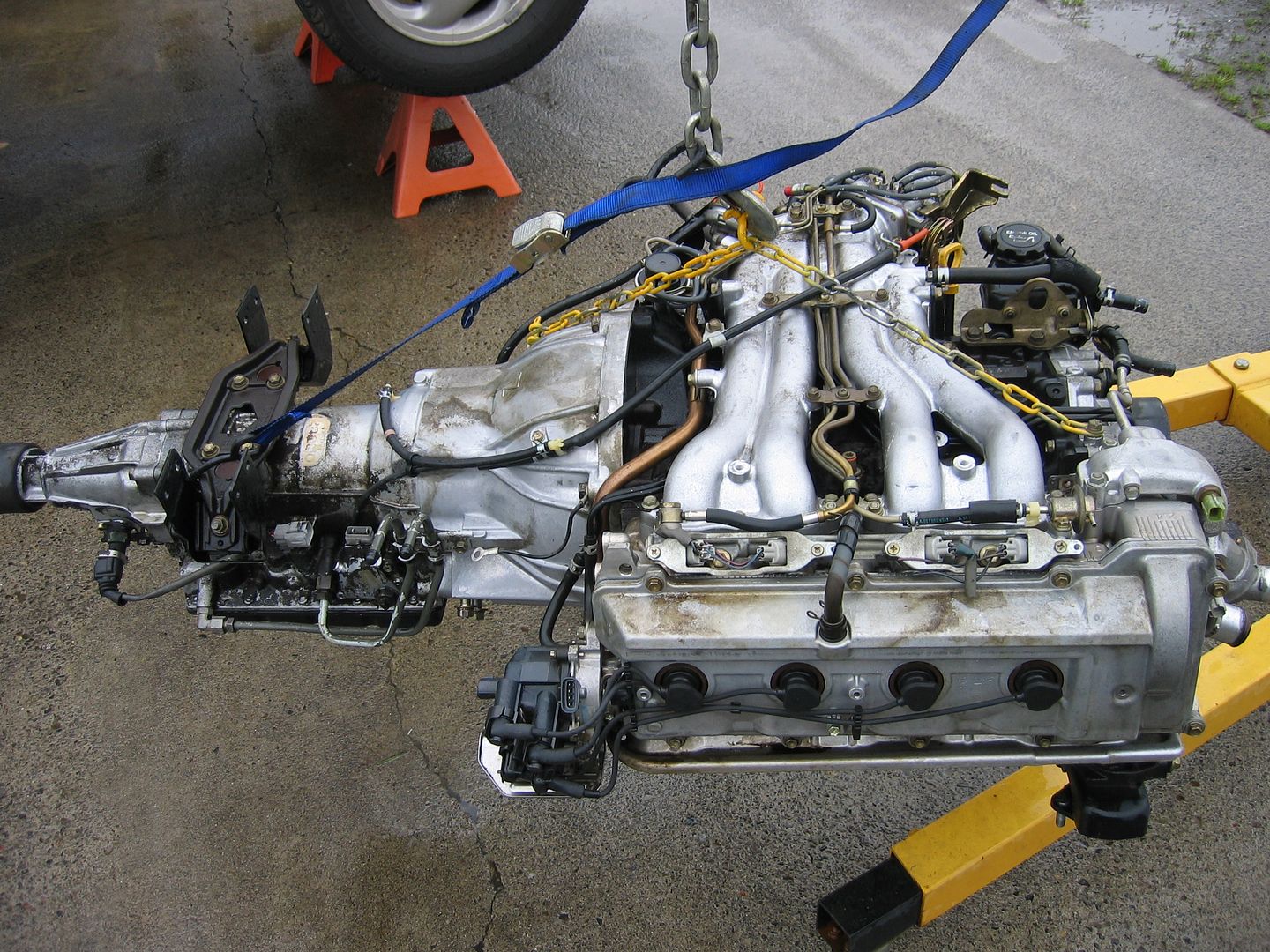Well, it is dark and I still haven't fixed the problem. I went out today expecting to run a new wire from the neutral start switch to the small plastic clip that goes into the starter. Before doing so I decided to quickly double check the wiring at the neutral start switch and at the starter. Both the "in" and "out" wires on the neutral start switch were over 10 volts when trying to crank, as expected. (Note: I unplugged the connector and got a reading of something like 12.2 volts going "in" and 0.0 volts coming "out". I was trying to verify which was the "in" and which the "out" for when I cut the wire. When I plugged it in and tested, however, both the "in" and "out" read 10.? volts. (sorry, I should write this down next time). They weren't identical, but they weren't off by more than .5 volts, which is what I was checking for.).
Moving over to the starter side, I unplugged the plastic clip and tested the voltage coming to there. This is where the results differed from last time. I am guessing that I somehow had a bad ground last time, because this time it read 12.3 volts when trying to crank. I had my wife turn the key and hold it 5+ times to make sure, and every time it went straight up to 12.31 and was stable there. Now, I still don't really know how starters work, but it seemed odd to me that when she stopped trying to crank but left the key in the "on" position, the wire only dropped to 11.81 volts. This happened every time she turned the key and then let it go. So there was a difference of exactly .5 volts between cranking and not cranking. The reason it seems odd is because, to me, it seems like it should be dropping to 0 volts when the key isn't cranking. I didn't even think until right now to have her take the key out. I tested the big positive wire at the starter command terminal coming directly from the battery as well, and that one stayed at 12.3 volts both while cranking and while not cranking.
Since I could see that the command terminal was getting 12.3 volts, and that the wire in the plastic clip was also getting 12.3 volts when cranking, I was confused. So I decided to do what I always do to start the car when it just clicks, and jump the command terminal to where the plastic clip is supposed to go. It cranked for a split second, as always, but then I accidentally moved the jumper wire a little bit and lost the connection. The weird thing was that when I touched it again to jump it, IT JUST CLICKED! I tried five times, and got one click every time. That was the first time I had ever jumped it like that and not had it crank. So then I remembered another article I had read and started thinking "starter contacts". (Since I don't know anything about electricity or starters, my idea was that the contacts had been going bad all along, but that somehow when I used my big jumper wire it brought a little more juice to the starter than the little clip, and although that had been enough to get it started, the contacts had now worn out enough to where even that wouldn't work). Since it was almost four and we'd need to drive to the Toyota dealership if I wanted to get the contacts today, I ran in and called to make sure they had the kit. They said they had the kit for $16.12 (Toyota part #28226-72010). So I went back outside and jumped the car again, and that time it started the first time, like it always had before. We drove there and got the kit, and the man also told us that the bottom contact was shaped differently than the top one. So to be safe we bought two different bottom copper contacts ($24/pair, different shapes) and the top kit. It was $43.95! But of course I told him I'd probably be returning most of it since I hadn't taken the starter apart yet (I had to get to the store and have only one car).
When I returned home, I took out the starter and removed the three screws. The contacts, to me, looked absolutely unworn. There was, however, some discoloring where the copper color was a little blackened. At least, they still looked new to me compared to the
photo on the article just mentioned. The metal itself was flush everywhere, and not filed down at all.
Another thing I noticed, however, was that where the plastic clip comes into the starter, there are two small wires that are soldered together. The picture below shows it a little better, but the right where the big silver bead is, one of the wires is not soldered to it. There is a small gap, and it appears to have broken off. It doesn't seem to me like this would make a difference, since the two wires are soldered together further up, and seem to be going to the same place, but just thought I'd point it out.
P1270400.jpg
Finally, I also noticed that the contacts in my starter didn't look like the contacts I got from the Toyota dealership. They also don't look like the ones on the same article I've been referring to. The picture below is of the contacts I bought for $43.95. Keep in mind I just replaced the previous starter with this refurbished one from AutoZone on December 21, 2011. It is supposed to be for a 1993 Previa (I have a '93, with a '91 replaced engine).
P1270406.jpg
I bench tested the starter, testing it about 5 times to make sure it worked every time. It did. I just tapped the wire for about 1/5th of a second each time so as to not overwork it. The command terminal was slightly loose, probably about one thread, so I tightened that up before reinstalling.
Once I reinstalled the starter, I cranked but got the same old click. 12.3 volts at the command terminal, and 12.3 volts at the clip while cranking (11.8 while key is just "on").
So, here's the only hypothesis I can come up with. As far as I can tell, the two 12.3 volt connections have to meet up somewhere inside the starter in order for it to spin. Would it be possible for that connection to be broken on the inside of the starter, but for the connection to be completed from the outside when I am jumping the command terminal to where the clip goes? Again, I don't really know how these work. It just doesn't make sense that the 12.3 volts from my jumper wire will start it every time (except for that one minute today, which I still don't understand), while the 12.3 volts from the clip will not.
I am very grateful for the advice I've been given so far. Thank you for bearing with me as I stumble along with this project. Any further help is greatly appreciated. Have a great weekend!
Tyson




 Reply With Quote
Reply With Quote


 Thanks for the kudos
Thanks for the kudos  . Good point. Sounds like yours was a bit like the situation in the thread Tyson linked to in his 1st post. When it comes to electrical problems on the Previa it's always a good idea to pull that box and check it. Once you know where the "secret" plastic locks are it only takes a few minutes to pop apart for a visual inspection. Elaborating on what you said, sometimes in cases of poor electrical contact (as in a corroded fuse box) electricity can flow when not under a heavy load. Then at the critical moment (when a load is applied) contact is lost. Although the fusible link box is one of the most likely places for that to occur, this type problem can be occur any number of places in any circuit (usually at switch contacts).
. Good point. Sounds like yours was a bit like the situation in the thread Tyson linked to in his 1st post. When it comes to electrical problems on the Previa it's always a good idea to pull that box and check it. Once you know where the "secret" plastic locks are it only takes a few minutes to pop apart for a visual inspection. Elaborating on what you said, sometimes in cases of poor electrical contact (as in a corroded fuse box) electricity can flow when not under a heavy load. Then at the critical moment (when a load is applied) contact is lost. Although the fusible link box is one of the most likely places for that to occur, this type problem can be occur any number of places in any circuit (usually at switch contacts). 
 . Turns out the starter had a shorted winding. The auto parts store replaced the starter for free, but I had to eat the other parts and my wasted time.
. Turns out the starter had a shorted winding. The auto parts store replaced the starter for free, but I had to eat the other parts and my wasted time.  Moral of the story.......you get what you pay for. These "lifetime" remanufactured auto parts are trash. Sounds like the core you gave them was better than what you got. This is the reason I quit buying that crap and keep repairing my original components whenever possible. When I do buy I spend the extra money and get from a reputable source (like an OEM factory rebuild). For those unable to repair/rebuild themselves another option is to take your starters/alternators into a local "auto electric" business that specializes in such repairs/rebuilds. Tim
Moral of the story.......you get what you pay for. These "lifetime" remanufactured auto parts are trash. Sounds like the core you gave them was better than what you got. This is the reason I quit buying that crap and keep repairing my original components whenever possible. When I do buy I spend the extra money and get from a reputable source (like an OEM factory rebuild). For those unable to repair/rebuild themselves another option is to take your starters/alternators into a local "auto electric" business that specializes in such repairs/rebuilds. Tim

